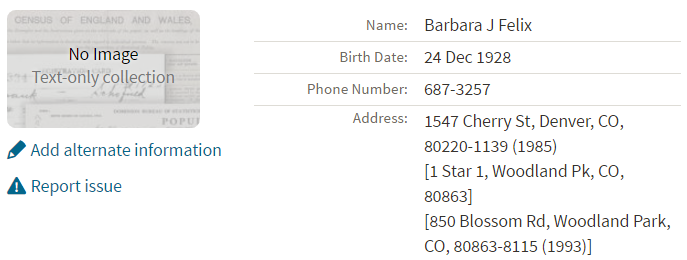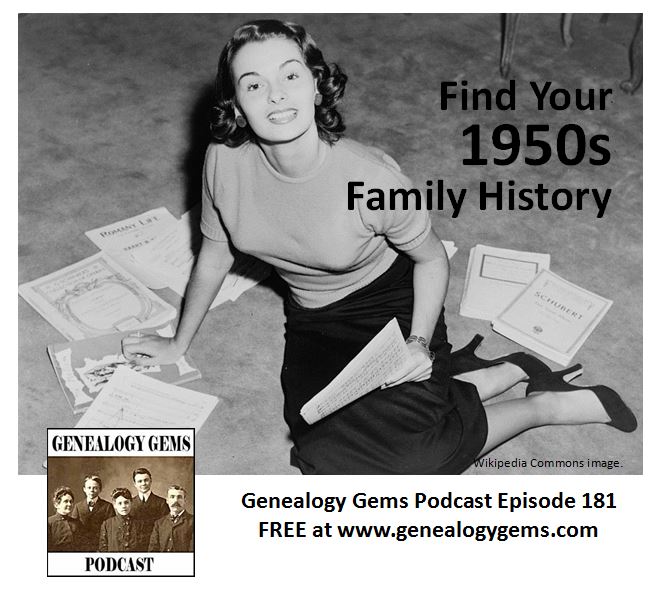The US Public Records Index can be useful for genealogy–if you understand what it is and how to use it properly. Here’s an example and some tips.
Not long Russ sent in this tip recommending the US Public Records Index for genealogy:
“I was listening to Genealogy Gems Podcast 181 [in which] you were talking about where do we search while we are waiting for the 1950 Census….I recently discovered a wonderful resource, on Ancestry.com, that I have used along with city directories. The name of the record group doesn’t sound interesting but it can be a Gem for you: the US Public Record Index, 1950-1993, Volume 1 and 2. Volume 1 is far more interesting with more data. A search will return a name AND birth date, along with more than one address, zip code and sometimes phone numbers.”
Here’s a sample search result:

Russ kindly sent me Ancestry’s description of its online database for Volume 1, which says that original data comes from public records spanning all 50 states, such as voter registration lists, public record filings, historical residential records and other household database listings.
Collection Profile
What: U.S. Public Records Index
Where: Ancestry, FamilySearch, MyHeritage
Years Spanned: 1950-2009
Source Type: Lacking original source citations. “Hints to go on and follow up with further research into verifiable sources.”
Then he shared the following example of using the US Public Records Index to find recent relatives that he can’t look up yet in the 1950 census:
“I had a hint for a cousin in a yearbook. I know that she recently lived in Philadelphia, Pennsylvania. I didn’t know where she went to college and I know her birthday. The name is not unique, not also not common. At the same time, I had the hint for the Public Record Index. You know those things we can’t use in a proof argument, but there [she] was in Philadelphia. The yearbook had her picture and only her name, not spelled the way I know it, but the Public Record Index puts her in Philadelphia at the right time and place.
I have seen 2 or 3 addresses for folks in the 1980s and 1990s in these indexes. Not all addresses have dates, but some do. I have one cousin with 5 addresses since 1983 and he won’t be in a census until the 1960 Census Records are released.”
Russ blogs about his family history at worthy2be.wordpress.com/. Thanks for the tip!
The U.S. Public Records Index pops up in my search results sometimes, too. Both volume 1 and volume 2 are searchable on Ancestry.com, as Russ says, in separate databases. Each has over 400,000 records in it. There’s also a free partial version of this database for 1970-2009 at FamilySearch.org and yet a third version at MyHeritage, with 816 million records, with nearly the same time frame. The FamilySearch database says its data comes from “telephone directories, property tax assessments, credit applications, and other records available to the public.”
More on the US Public Records Index
Here are a few tips worth mentioning about the US Public Records Index. Some of these points come from the FamilySearch wiki:
- Not everyone who lived in the U.S. appears in the index, and you’re more likely to find birth information for those born between 1900 and 1990. What you’ll find is primarily where someone lived, and often when they lived there.
- It’s rarely possible to positively identify a relative in this index since there’s limited information and it spans the entire country for up to a half-century, and you can’t follow up on the record it comes from because the index doesn’t say where individual records come from. So as Russ says, this is a great resource to use in combination with other records. It’s a similar concept to the way you might consult family trees that lack sources: hints to go on and follow up with further research into verifiable sources.
- When you find more recent listings, you can sometimes find telephone numbers for living distant relatives. If the thought of cold-calling distant relatives seems a little intimidating, listen to my Family History: Genealogy Made Easy podcast, episodes 14-15, for tips–and to get your courage up!
 More Gems on Researching Recent Relatives
More Gems on Researching Recent Relatives
- The 1950 Census Substitute: What to Use Until Its Release Date
- Google Earth for Genealogy: Map Your Own Childhood Homes
- World War II Military Yearbooks

Lisa,
Thanks for the mention and sharing of my experience. It took me a while to even look at those records, but once I looked at them, I will look at these records and use them. The Volume 1 records may give you multiple years of information, mostly addresses, but some times phone numbers.
I will be better prepared for the availability of the 1950 Census Records than I was for the 1940 Census Records where we had the opportunity to Browse them.
Thank you and keep up the GREAT Work.
Russ
Thanks Russ!!
Having multiple addresses doesn’t mean one lived in all of those addresses. I looked myself up and saw that I was associated with one of my mom’s addresses where I never lived, but because we were on a bank account together, my name became associated with her address. So it’s good to understand a similar situation may exist in the records of one’s relatives.
Excellent reminder. That is true on all of the ‘people directory’ websites out there. It’s a great way to track down connections.
Is there a site for city directories during the 1860-1880 period?
There isn’t one with ALL city directories. It all depends on the city. I would start by going to the FamilySearch Wiki at https://familysearch.org/wiki/en and searching for the name of the city and “city directories”. A Google search would also do well to identify where city directories are held for the location you are researching.
A trick for coaxing a little more info from this database in Ancestry. They index the street address as well, though it is not obvious how to search for it. You need to use the catch-all “Keyword” field. So if you put, say, “123 Elm” and then limit the “Lived in” field to the town, you can sometimes get a listing of all the adults who lived at that address. The names in that household then can give something more significant to correlate with a known family. The same trick often works with directories.